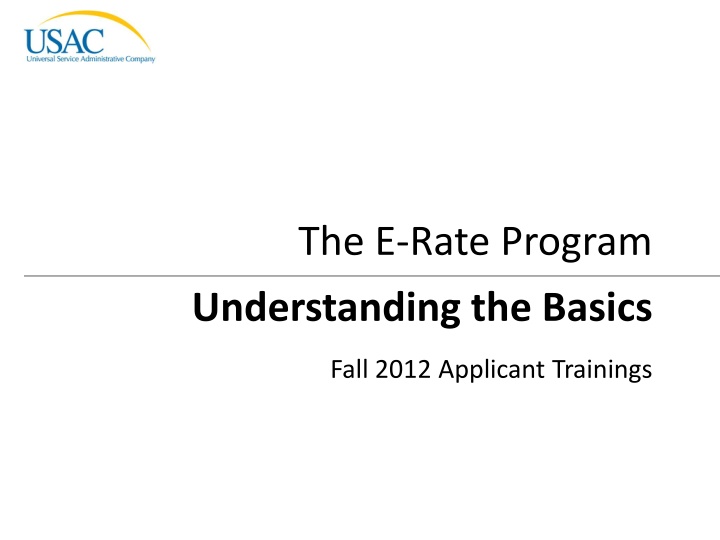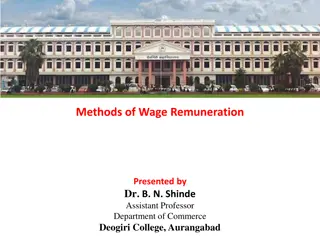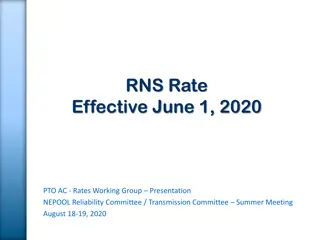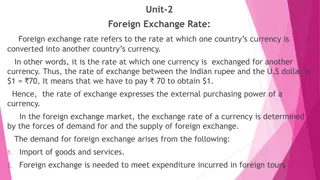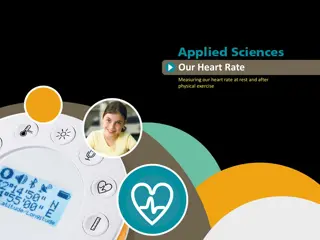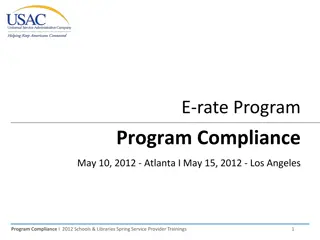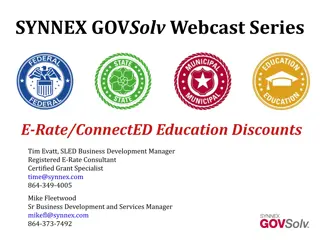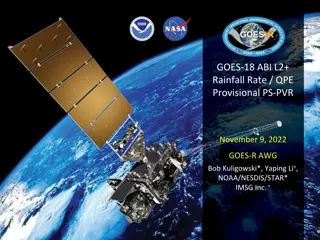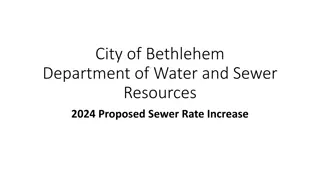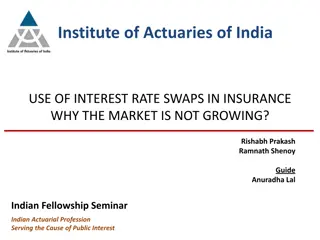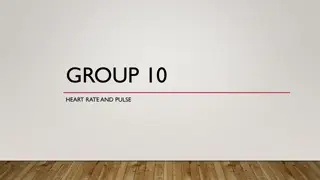E-Rate Program Basics Overview
General information about the E-Rate program, including technology planning, service requests, competitive bidding, order processing, application review, funding commitments, service initiation, invoicing, deadlines, organization structure, rules, timeline, and budget.
Download Presentation

Please find below an Image/Link to download the presentation.
The content on the website is provided AS IS for your information and personal use only. It may not be sold, licensed, or shared on other websites without obtaining consent from the author.If you encounter any issues during the download, it is possible that the publisher has removed the file from their server.
You are allowed to download the files provided on this website for personal or commercial use, subject to the condition that they are used lawfully. All files are the property of their respective owners.
The content on the website is provided AS IS for your information and personal use only. It may not be sold, licensed, or shared on other websites without obtaining consent from the author.
E N D
Presentation Transcript
The E-Rate Program Understanding the Basics Fall 2012 Applicant Trainings Beginner s Presentation I 2012 Schools and Libraries Fall Applicant Trainings 1
Understanding the Basics Overview General information about E-rate Technology planning Requesting services (FCC Form 470) Competitive bidding process Ordering services (FCC Form 471) Application review and funding commitments Begin receiving services (FCC Form 486) Invoicing USAC (FCC Form 472 and FCC Form 474) Deadlines Beginner s Presentation I 2012 Schools and Libraries Fall Applicant Trainings 2
Understanding the Basics General E-rate Information Beginner s Presentation I 2012 Schools and Libraries Fall Applicant Trainings 3
General E-rate Information E-rate Organization Federal Communications Commission (FCC), an independent U.S. government agency, established and oversees the E-rate program Universal Service Administrative Company (USAC), a not- for-profit, administers the E-rate program along with three other programs Schools and Libraries Program (SL) is the part of USAC with responsibility for E-rate Beginner s Presentation I 2012 Schools and Libraries Fall Applicant Trainings 4
General E-rate Information E-rate Rules Congress directed the FCC to establish the E-rate program in 1996 The FCC sets rules and policies through orders USAC and the Schools and Libraries Program develop procedures for specific actions, such as how to process applications Beginner s Presentation I 2012 Schools and Libraries Fall Applicant Trainings 5
General E-rate Information E-rate Timeline Commitments for E-rate are made by the funding year (FY), which runs from July 1 through the following June 30 USAC refers to the funding year as the year in which most services will begin, e.g., FY2012 is July 1, 2012 to June 30, 2013 Beginner s Presentation I 2012 Schools and Libraries Fall Applicant Trainings 6
General E-rate Information E-rate Budget The FCC has set the E-rate fund at $2.25 billion for each funding year. However, beginning in FY 2010, the cap is now adjusted for inflation each year Once each year, FCC can roll over unused funds from previous funding years into the current funding year Beginner s Presentation I 2012 Schools and Libraries Fall Applicant Trainings 7
General E-rate Information E-rate Eligibility Who is eligible for E-rate funding? Schools and school districts Non-traditional facilities (conditionally by state) Libraries and library systems Consortia groups of eligible entities that band together to aggregate demand and negotiate lower prices Beginner s Presentation I 2012 Schools and Libraries Fall Applicant Trainings 8
General E-rate Information E-rate Discounts How large are the discounts on eligible products and services? Discounts are 20-90 percent of eligible costs Discount level for a school or library depends on: Percentage of students who are eligible for National School Lunch Program (NSLP) in (for a school) the school (for a library) the school district in which the library is located Urban or rural location of the school or library Beginner s Presentation I 2012 Schools and Libraries Fall Applicant Trainings 9
General E-rate Information Discount Matrix INCOME URBAN LOCATION Discount ...and you re in an URBAN area, your discount will be... 20% RURAL LOCATION Discount ...and you re in a RURAL area, your discount will be... 25% % of students eligible for NSLP If the % eligible is... Less than 1% 1% to 19% 40% 50% 20% to 34% 50% 60% 35% to 49% 60% 70% 50% to 74% 80% 80% 75% to 100% 90% 90% Beginner s Presentation I 2012 Schools and Libraries Fall Applicant Trainings 10
General E-rate Information E-rate Categories of Service Priority 1 (P1): funded first Telecommunications Services Internet Access Telecommunications Priority 2 (P2): funding starts with neediest applicants Internal Connections Basic Maintenance of Internal Connections Beginner s Presentation I 2012 Schools and Libraries Fall Applicant Trainings 11
General E-rate Information E-rate Forms How do I file a program form? Three options: File online, certify on paper File online, certify online File on paper, certify on paper Two versions of each online form: standard and interview Note: USAC encourages you to file online, because online filing speeds processing and reduces errors Beginner s Presentation I 2012 Schools and Libraries Fall Applicant Trainings 12
General E-rate Information E-rate Letters Each time you file a program form, USAC sends you a letter Letters are color-coded by funding year 2011 2012 2013 Pink Blue Canary Note: When storing documents, USAC encourages you to separate your program forms and letters by funding year to better organize them Beginner s Presentation I 2012 Schools and Libraries Fall Applicant Trainings 13
Understanding the Basics Technology Planning Beginner s Presentation I 2012 Schools and Libraries Fall Applicant Trainings 14
Technology Planning Technology Planning FCC Form 470 and RNL Competitive Bidding FCC Form 471 and RAL Application Review and FCDL FCC Form 486 FCC Forms 472 (BEAR) and 474 (SPI) Beginner s Presentation I 2012 Schools and Libraries Fall Applicant Trainings 15
Technology Planning Tech Plan Elements A technology plan must contain the following elements: Goals and strategies for using technology to improve education or library services Needs assessment Staff training Evaluation plan Note: Starting with FY2011, if you are only requesting P1 services, a technology plan is not required Beginner s Presentation I 2012 Schools and Libraries Fall Applicant Trainings 16
Technology Planning Tech Plan Deadlines Your technology plan must be approved by a USAC- certified Technology Plan Approver on or before the date when you begin receiving services or at the time you file the FCC Form 486, whichever date is earlier Beginner s Presentation I 2012 Schools and Libraries Fall Applicant Trainings 17
Technology Planning Acronyms and Terms Four elements: the four required topics you must address in your technology plan Technology Plan Approver (TPA): the agency/person certified by USAC that approves your technology plan Beginner s Presentation I 2012 Schools and Libraries Fall Applicant Trainings 18
Understanding the Basics Requesting Service (FCC Form 470) Beginner s Presentation I 2012 Schools and Libraries Fall Applicant Trainings 19
Requesting Service Technology Planning FCC Form 470 Competitive Bidding FCC Form 471 Application Review and FCDL FCC Form 486 FCC Forms 472 (BEAR) and 474 (SPI) Beginner s Presentation I 2012 Schools and Libraries Fall Applicant Trainings 20
Requesting Service FCC Form 470 Purpose Open a competitive bidding process Identify and describe desired categories of service and function of the services Describe scope of your needs Notify potential bidders of the types and quantities of services that you need Note: RFPs may be used to describe specific needs and circumstances Beginner s Presentation I 2012 Schools and Libraries Fall Applicant Trainings 21
Requesting Service Acronyms and Terms Billed Entity Number (BEN): an identification number assigned by USAC to each school or library building Personal Identification Number (PIN): a code assigned by USAC to applicants for use in certifying program forms online USAC issues a PIN to every new authorized person filing a paper FCC Form 470, 471, or 486 Beginner s Presentation I 2012 Schools and Libraries Fall Applicant Trainings 22
Requesting Service Acronyms and Terms Request for Proposals (RFP): a bidding document (not required by E-rate) that provides detailed information about your services, locations, bid submission requirements, etc. Some states or procurement agencies refer to these documents by other names, e.g., Invitation for Bids (IFB) If an RFP is required by your state/local procurement rules, you must issue one Beginner s Presentation I 2012 Schools and Libraries Fall Applicant Trainings 23
Requesting Service Acronyms and Terms FCC Form 470 Receipt Notification Letter (RNL): a letter issued by USAC to the applicant that summarizes the information provided in the FCC Form 470 Allowable Vendor Selection/Contract Date (ACD): the date which marks 28 days after the FCC Form 470 is posted to the USAC website Beginner s Presentation I 2012 Schools and Libraries Fall Applicant Trainings 24
Understanding the Basics Competitive Bidding Beginner s Presentation I 2012 Schools and Libraries Fall Applicant Trainings 25
Competitive Bidding Technology Planning FCC Form 470 Competitive Bidding FCC Form 471 Application Review and FCDL FCC Form 486 FCC Forms 472 (BEAR) and 474 (SPI) Beginner s Presentation I 2012 Schools and Libraries Fall Applicant Trainings 26
Competitive Bidding Competitive Bidding Requirements You must ensure that the competitive bidding process is open and fair. You must keep all incoming bids/correspondence with bidders and Evaluate bids equally All potential bidders have access to the information from your FCC Form 470 and RFP (if you filed one), and they can respond to your requests. Beginner s Presentation I 2012 Schools and Libraries Fall Applicant Trainings 27
Competitive Bidding Examples of Rule Violations The applicant has a relationship with a service provider that would unfairly influence the outcome of a competition or furnish the service provider with inside information Someone other than the applicant or an authorized representative of the applicant prepares, signs or submits the FCC Form 470 and certification Beginner s Presentation I 2012 Schools and Libraries Fall Applicant Trainings 28
Competitive Bidding Examples of Rule Violations A service provider representative is listed as the FCC Form 470 contact person and that service provider is allowed to participate in the competitive bidding process. The FCC Form 470 does not describe the desired products and services with sufficient specificity to enable interested parties to submit bid responses. Beginner s Presentation I 2012 Schools and Libraries Fall Applicant Trainings 29
Competitive Bidding Acronyms and Terms Bid: A service provider response to your FCC Form 470 and/or RFP that contains services and prices and any other information you have requested Price of eligible products and services as the primary factor: In evaluating bids, the price of the eligible products and services must be the most heavily weighted factor in your evaluation of bids Beginner s Presentation I 2012 Schools and Libraries Fall Applicant Trainings 30
Competitive Bidding Bid Evaluation Matrix (sample) Factor Points Available Vendor 1 Vendor 2 Vendor 3 Price of the ELIGIBLE goods and services 30 15 30 25 20 20 0 20 Prior experience w/ vendor Prices for ineligible services, products and fees 25 20 15 25 15 0 15 15 Flexible Invoicing: 472 or 474 5 5 5 5 3 5 2 5 Environmental objectives Local or in-state vendor 92 100 65 68 Total Beginner s Presentation I 2012 Schools and Libraries Fall Applicant Trainings 31
Competitive Bidding Choosing a Service Provider After you close the competitive bidding process for your services (on or after the ACD), you can: Evaluate bids received Choose your service provider(s) Sign a contract Submit an FCC Form 471 Beginner s Presentation I 2012 Schools and Libraries Fall Applicant Trainings 32
Understanding the Basics Ordering Services (FCC Form 471) Beginner s Presentation I 2012 Schools and Libraries Fall Applicant Trainings 33
Ordering Services Technology Planning FCC Form 470 Competitive Bidding FCC Form 471 Application Review and FCDL FCC Form 486 FCC Forms 472 (BEAR) and 474 (SPI) Beginner s Presentation I 2012 Schools and Libraries Fall Applicant Trainings 34
Ordering Services FCC Form 471 Purpose Identify the service providers and eligible services you have chosen Identify the eligible schools and libraries that will receive services Calculate how much support you seek for the year Include your discount calculation information Certify your compliance with program rules Beginner s Presentation I 2012 Schools and Libraries Fall Applicant Trainings 35
Ordering Services Acronyms and Terms Funding Request Number (FRN): The identification number assigned to each FCC Form 471 Block 5 funding request Service Provider Identification Number (SPIN): The identification number assigned by USAC to a service provider Note: A service provider may register multiple SPINs to use for separate business units or states in which they operate Beginner s Presentation I 2012 Schools and Libraries Fall Applicant Trainings 36
Ordering Services Acronyms and Terms Item 21 Attachment (Item 21): The description of services (including price) associated with a funding request Can be submitted online, by fax, email, or on paper Attachment(s) are part of the FCC Form 471 and they should be submitted by the close of the application filing window to ensure that the FCC Form 471 is treated as on time Beginner s Presentation I 2012 Schools and Libraries Fall Applicant Trainings 37
Ordering Services Acronyms and Terms Receipt Acknowledgment Letter (RAL): A letter issued by USAC to the applicant and the service provider that summarizes the information provided in the FCC Form 471 Many of the entries on the form can be corrected after submission by using the RAL Ministerial and clerical errors can be corrected until USAC issues the letter containing USAC s decisions on your funding requests Beginner s Presentation I 2012 Schools and Libraries Fall Applicant Trainings 38
Ordering Services Acronyms and Terms Non-instructional Facility (NIF): A school building with no classrooms or a library building with no public areas NIFs are eligible for Priority 1 services NIFs are eligible for Priority 2 services only if necessary to provide effective transport of information to classrooms or public areas of libraries Beginner s Presentation I 2012 Schools and Libraries Fall Applicant Trainings 39
Understanding the Basics Application Review and Funding Commitments Beginner s Presentation I 2012 Schools and Libraries Fall Applicant Trainings 40
Application Review/Commitments Technology Planning FCC Form 470 Competitive Bidding FCC Form 471 Application Review and FCDL FCC Form 486 FCC Forms 472 (BEAR) and 474 (SPI) Beginner s Presentation I 2012 Schools and Libraries Fall Applicant Trainings 41
Application Review/Commitments Acronyms and Terms Program Integrity Assurance (PIA): The USAC group that reviews and makes funding decisions on program applications Funding Commitment Decision Letter (FCDL): Letter issued by USAC to the applicant and the service provider that contains decisions on their funding requests Beginner s Presentation I 2012 Schools and Libraries Fall Applicant Trainings 42
Application Review/Commitments PIA and USAC Reviews, FCC Form(s) 471 Verify eligibility of the schools and libraries and their discount levels Verify that the services requested are eligible for E-rate discounts Give you an opportunity to make allowable corrections to your form In some cases, ask for additional verification of your compliance with program rules Beginner s Presentation I 2012 Schools and Libraries Fall Applicant Trainings 43
Application Review/Commitments Receiving Your Funding Commitment Following application review, USAC issues an FCDL to both the applicant and the service provider(s) Applicants and service providers should carefully review their FCDL for details on approved or denied requests and your next steps (such as the deadline for filing an appeal) Beginner s Presentation I 2012 Schools and Libraries Fall Applicant Trainings 44
Understanding the Basics Begin Receiving Services (FCC Form 486) Beginner s Presentation I 2012 Schools and Libraries Fall Applicant Trainings 45
Begin Receiving Services Technology Planning FCC Form 470 Competitive Bidding FCC Form 471 Application Review and FCDL FCC Form 486 FCC Forms 472 (BEAR) and 474 (SPI) Beginner s Presentation I 2012 Schools and Libraries Fall Applicant Trainings 46
Begin Receiving Services FCC Form 486 Purpose Notify USAC that your eligible services have started or been delivered and invoices for those services can be processed and paid Provide the name of the TPA that approved your technology plan Report your status of compliance with CIPA Beginner s Presentation I 2012 Schools and Libraries Fall Applicant Trainings 47
Begin Receiving Services Acronyms and Terms FCC Form 486 Notification Letter: a letter issued by USAC to the applicant and service provider after an FCC Form 486 has been processed Children s Internet Protection Act (CIPA): a law with specific requirements on Internet safety policies and filtering Beginner s Presentation I 2012 Schools and Libraries Fall Applicant Trainings 48
Understanding the Basics Invoicing USAC (FCC Forms 472, 474) Beginner s Presentation I 2012 Schools and Libraries Fall Applicant Trainings 49
Invoicing USAC Technology Planning FCC Form 470 Competitive Bidding FCC Form 471 Application Review and FCDL FCC Form 486 FCC Forms 472 (BEAR) and 474 (SPI) Beginner s Presentation I 2012 Schools and Libraries Fall Applicant Trainings 50
